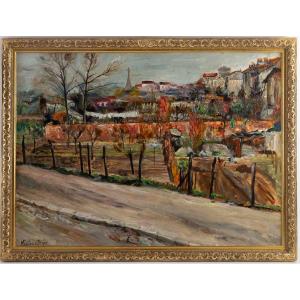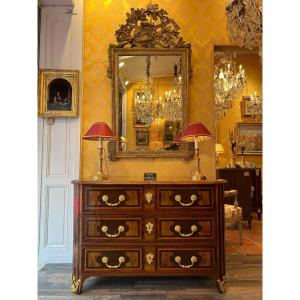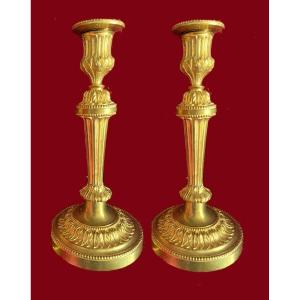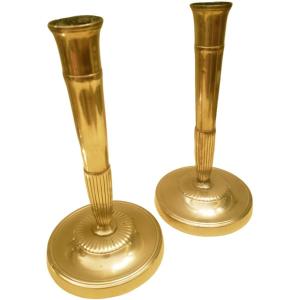Pair of Louis XVI Style Candlesticks, circa 1820, after Jean-François Rémond
François Rémond, a master chaser-gilder since 1774 and also a founder, drew inspiration from a drawing by Jean-Démosthène Dugourc, dated 1790 and preserved at the Musée des Arts Décoratifs in Paris, to create this magnificent pair of flambeaux in the Etruscan-antique style.
This rare and highly decorative pair of flambeaux in finely chiseled bronze, with its original gilding, is topped by an antique-style vase forming a binet. The shaft is adorned with three female terms featuring Louis XIV mascarons on the chest, embellished with garlands of flowers, and ending in three pairs of sandaled feet. The base is decorated with acanthus leaves and encircled by a pearl frieze.
This Parisian work from the early 19th century, circa 1820, demonstrates great artistic mastery.
Dimensions:
- Height: 12.8 inches
- Base Diameter: 5.7 inches
The ornamental designer Jean-Démosthène Dugourc (1749-1825) inspired many artists of his time. His talent is evident in various fields of decorative arts, notably in the fabrics of Camille Pernon, the furniture of Georges Jacob, the projects of his brother-in-law, the architect François-Joseph Belanger, and the bronze production of Gouthière or Thomire.
Appointed as a designer for the Garde-Meuble de la Couronne and intendant of buildings for Monsieur, the king's brother, in 1784, his repertoire blends a return to antiquity with natural inspiration. He disseminated his ideas in 1782 with the publication of his collection of Arabesques.
An identical model, dated 1785, is preserved at Pillnitz Castle near Dresden. Two other models of flambeaux, preserved at the Wallace Collection in London, also illustrate the collaboration between Dugourc and Rémond. The first model, dating from 1783, features a shaft with four terms supporting an octagonal base adorned with rosettes and satyr heads, commissioned by the merchant-haberdasher Dominique Daguerre.
Rémond was not the only one inspired by Dugourc. His influence can also be seen in the works of Louis-Simon Boizot and Claude-Jean Pitoin. The latter provided Marie-Antoinette, for the birth of the dauphin in 1781, with a pair of flambeaux featuring three female terms resting on a base adorned with three dolphins, intended for the Méridienne in her private apartments at Versailles, also preserved at the Wallace Collection.
Bibliography:
- A. Gruber, *L'art décoratif en Europe : du néoclassicisme à l'art Déco*, p. 94
- P. Hughes, *The Wallace Collection: Catalogue of Furniture*, p. 1247-1263
- H. Ottomeyer, *Vergoldete Bronzen*, vol. 1, p. 286, ill. 4.15.2


















































 Le Magazine de PROANTIC
Le Magazine de PROANTIC TRÉSORS Magazine
TRÉSORS Magazine Rivista Artiquariato
Rivista Artiquariato